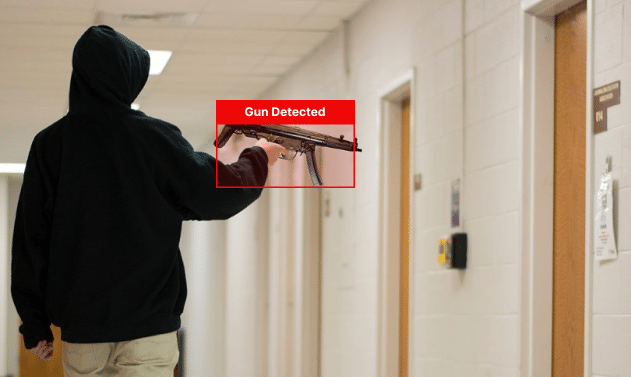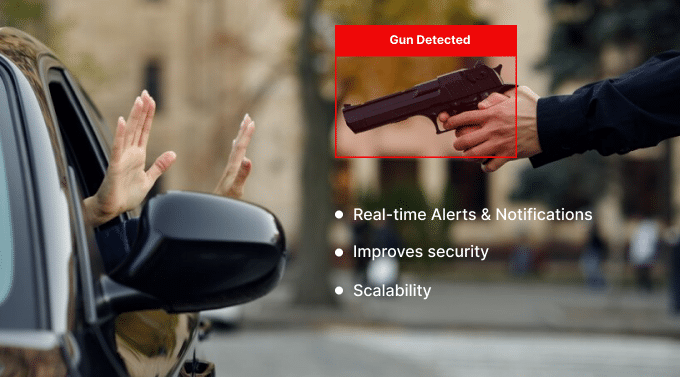- 6 min read
- Aug 23, 2024
- 0

In recent eras, the need for security has taken center stage. The rising concerns over safety across different areas have spread majorly. Identifying potential threats efficiently with advanced detection methods spread across various sectors from public spaces to private institutions has become increasingly important. With the advent of AI-powered systems, the scenario of active security systems has transformed. Modern detection systems use sophisticated algorithms and machine learning techniques to recognize threats more accurately. It is capable of detecting vast amounts of data in real time.
With mass shootings in different public locations like schools, the majority of the US nation has adopted AI technology
One of the relevant elements of the systems is the integration of surveillance cameras. The cameras are capable of capturing video streams that can be analyzed by AI algorithms for detecting any suspicious behaviour and objects. Object detection algorithms like YOLO and MobileNet that are widely utilized for identifying the presence of weapons in robberies. The algorithms are trained on large datasets that can identify weapons in violence and robbery in a fight.
Here’s an overview of how AI has proved beneficial in detecting weapons and violence. Harnessing the power of deep learning, the technologies are becoming skilled at distinguishing between normal activities and potential threats. With continuous improvements in AI software and machine learning it paves the way for developing effective solutions for computer vision in maintaining safety & security. This blog post discusses the multifaceted ways in which AI have transformed the delineation of security in different environments right from public spaces to private facilities.
Impact of AI on weapon detection

With the increasing security concerns across the globe, it is relevant for industries and smart city urban planners to embrace AI in the field of weapon detection. Using deep learning algorithms AI Video analytics software can analyze video streams gathered from security cameras recognizing the presence of weapons with complete precision. Neural networks are trained on a range of datasets comprising real-world scenarios of usual and unusual activities. AI models use this data to analyze patterns that address the presence of weapons.
Real-time alerts & notifications
One of the foremost functional advantages of AI in weapon detection is providing real-time alerts and notifications on the detection of arms within the surveillance vicinity. Several deep learning models like MobileNet and YOLO process video footage in real-time. It can identify objects and arms with accuracy.
Improves security
Having a proven track record of precision in arms identification, and computer vision in security and safety helped in preventing incidents of gun violence. It detects arms and weapons by harnessing the power of AI and deep learning avoiding any culmination of events.
Serving as a proactive approach to public safety and security, the advanced intelligence software ensures potential threats are at bay. The integration of AI in security is evolving rapidly creating transparent solutions for industries.
Scalability
Gathering video/image data from multiple security cameras, the AI surveillance software provides comprehensive coverage of large areas. Owing to its scalable approaches, AI can be used by law enforcement agencies and security firms to identify weapons in suspected locations. For instance, object detection tools like YOLO (‘You Only Look Once’) process video/image frames to simultaneously predict multiple objects for computer vision tasks.
How can AI weapon detection be integrated into existing security infrastructure?
Employing real-time computer vision intelligence is critical for improving security and safety in different environments. The technology uses advanced detection models and deep learning algorithms to identify the presence of weapons with accuracy. The primary element of weapon detection is the detection dataset which includes images and videos presenting real-world situations.
The datasets are trained with synthetic simulations administering valuable resources for training AI models. Similarly, powerful APIs and integrations play a major role in integrating weapon detection systems into existing security infrastructures. It helps in establishing seamless communication between distinct software elements ensuring that detection models can be easily implemented across different platforms.
Improving security with AI detection of weapons
From providing comprehensive security solutions to advanced detection of objects, computer vision AI is highly efficient in enhancing security measures across different environments. Its capability to process large amounts of data using excellent neural networks and deep learning algorithms for analyzing security camera video data in real time. It enables immediate detection of weapons and violent activities.
At Nextbrain, our AI platform focuses on improving security operations ensuring a premium security of public safety. With the security scenario continuing to evolve, our technology strives to stay ahead of the competitive curve by delivering best-in-class solutions for meeting the rising demand for weapon detection systems.
Violence detection in real-time
When it comes to violent activities, real-time detection is crucial in maintaining public safety across environments prone to violence. With the integration of video analytics AI, security systems across industries respond quickly to threats. AI-powered technology analyzes video/image data gathered from security cameras in real-time recognizing suspicious behaviour and detecting arms alongside.
Video analytics AI leverages deep learning to process huge amounts of data from security cameras. The system uses detection models that capture temporal dependencies within video streams enabling the accurate identification of violent activities. It analyzes the sequences and detects anomalies that could indicate potential threats. Real-time violence detection systems offer automatic detection and alert capabilities in security infrastructure. The systems are designed to work seamlessly with existing security infrastructure comprising security cameras and surveillance networks. By harnessing the power of AI and video analytics, organizations are capable of implementing advanced security measures that reduce the risk of violence in public spaces.
What is the future of weapon detection technology?
Standing on the verge of 2024, it can be well expected that AI in object detection is advancing rapidly. The AI technologies utilize AI-powered systems to analyze security camera footage in real-time administering automatic identification and detection. With the development of open-source detection models available on platforms, it will facilitate greater collaboration and innovation in the field.
Wrapping up
It can be concluded that future developments will majorly focus on advancing the speed and accuracy of detection models integrating more advanced AI capabilities. It expands the use of open-source tools and datasets effectively improving the capability to detect and respond to threats. Are you in search of AI detection software for your working facility infrastructure? At Nextbrain, we have a core team of dedicated professionals with years of experience in developing expert solutions for different businesses. Nextbrain provides a comprehensive evaluation and industry-leading solutions for protecting and connecting different environments.
Connect with our professionals to know more about AI detection of weapons and violence.

